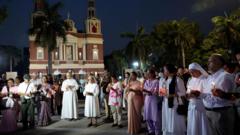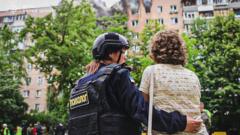The South Korean government is set to deploy drones at airports in early 2026 as a preventive measure against bird strikes following the tragic crash of Jeju Air Flight 2216. Enhanced safety protocols will also include infrastructure upgrades and addressing pilot fatigue.
South Korea's Drone Initiative Aims to Enhance Airport Safety After Tragic Air Crash

South Korea's Drone Initiative Aims to Enhance Airport Safety After Tragic Air Crash
In response to last year's deadly air crash, South Korea plans to implement drones at airports to deter bird strikes and improve aviation safety measures.
South Korea's aviation authorities have announced significant measures to improve air travel safety, particularly following the tragic crash of Jeju Air Flight 2216 on December 29, 2024, which claimed the lives of 179 individuals. The government revealed plans to deploy drones at airports starting in the first half of 2026, targeting bird strikes as a significant threat to aircraft during critical phases of landing.
The crash at Muan International Airport occurred shortly after pilots declared an emergency due to a suspected bird strike while descending. Following a sharp turn, the aircraft landed on its belly, collided with a concrete barrier, and subsequently erupted in flames, highlighting an urgent need for infrastructural changes. In response, the government intends to replace rigid antenna structures that can incur severe damage during incidents with more flexible and breakable alternatives.
Preliminary investigations indicated the presence of bird remains in the engines, leading to a recognition that preventative measures against bird strikes were overdue. Documents unearthed by The New York Times have revealed that the Korea Airports Corporation had been previously warned about the risks associated with bird activity around Muan International Airport.
In addition to the drone strategy, which will utilize technology to identify birds and deploy repellents, the transport ministry is also planning renovations to six key airports by the end of the year. Additional initiatives include measures to combat pilot fatigue and enhancing the number of safety supervisors across the aviation sector.
The anticipated introduction of drones for bird deterrence aligns with global practices, as many airports have successfully utilized this technology to protect flights from avian disruptions. This comprehensive approach underscores South Korea's commitment to rectify existing safety vulnerabilities and prevent future aviation disasters.
The crash at Muan International Airport occurred shortly after pilots declared an emergency due to a suspected bird strike while descending. Following a sharp turn, the aircraft landed on its belly, collided with a concrete barrier, and subsequently erupted in flames, highlighting an urgent need for infrastructural changes. In response, the government intends to replace rigid antenna structures that can incur severe damage during incidents with more flexible and breakable alternatives.
Preliminary investigations indicated the presence of bird remains in the engines, leading to a recognition that preventative measures against bird strikes were overdue. Documents unearthed by The New York Times have revealed that the Korea Airports Corporation had been previously warned about the risks associated with bird activity around Muan International Airport.
In addition to the drone strategy, which will utilize technology to identify birds and deploy repellents, the transport ministry is also planning renovations to six key airports by the end of the year. Additional initiatives include measures to combat pilot fatigue and enhancing the number of safety supervisors across the aviation sector.
The anticipated introduction of drones for bird deterrence aligns with global practices, as many airports have successfully utilized this technology to protect flights from avian disruptions. This comprehensive approach underscores South Korea's commitment to rectify existing safety vulnerabilities and prevent future aviation disasters.























